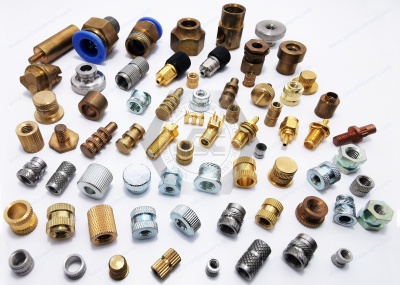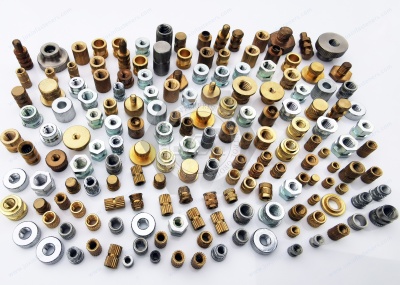Call Us
+86 136 6007 9809
Call Us
+86 136 6007 9809
Nov. 22, 2023
Insert nut is a kind of insert with internal thread and external knurled or other patterns buried in plastic or other alloy products (mainly used in plastic products) so that the primary product forms effective thread products. The embedded nut is suitable for all plastic materials; the insert is set into the mold needle before the plastic injection and then injected glue; the mold injection insert is generally designed to be a straight pattern, so the insert cost is relatively lower, direct molding in the mold can obtain the best torque and tensile performance, and allow for smaller wall thickness, the insert nut is widely used in all walks of life.
Heat-set inserts for plastic classification:All kinds of thermoplastic, thermosetting plastic parts and special inserts are suitable for different use requirements, such as hot melt, ultrasonic insert, injection molding insert, and cold pressing insert.
1. Cold-pressed series: Cold-pressed inserts are suitable for thermoplastics with medium or low hardness and are cold-pressed directly into prefabricated plastic holes after the plastic parts are formed. The outstanding advantage of cold-pressed inserts is easy implantation and high efficiency but at the expense of torsion and tension performance. Some cold-pressed inserts can be implanted by ultrasonic or hot melt processes for better torque and tensile properties.
2. Hot melt and ultrasonic series: hot melt is to heat the product and press the copper insert into the plastic matrix to speed up the work efficiency, and the heated copper insert can also quickly conduct the heat to the plastic parts so that the plastic hole around the soft so that the product is quickly pressed into the hole. Due to the embossing process of the outer diameter of the insert, after forming, it forms an inevitable friction and bite force with the copper insert, which can fix it on the inside so that it can not fall off. With a specific torque and tension.
3. In-mold injection molding series: in-mold injection molding inserts are suitable for all plastic materials. Before the plastic injection, the inserts are set in the mold needle and then injected with glue. In-mold injection inserts are generally designed with straight patterns, so the insert cost is relatively lower. Forming directly in the mold allows for the best torque and tension performance and a smaller wall thickness, with the disadvantage of low efficiency.
4. Self-tapping series: self-tapping inserts are suitable for different materials; plastic materials are mainly thermosetting plastics, which can directly penetrate the plastic hole. Refer to screw inserts.
5. Automatic nut implantation machine series: The latest insert technology is a three-axis CNC nut implantation machine introduced by Shenda CNC to carry out efficient implant nut insertion; this equipment adopts a servo drive system imported from Japan, computer programming control operation is convenient, and fast, CNC machine production efficiency is fast, the machine as long as a debugging is completed no matter when the conversion is speedy. Just find the product program in the corresponding folder and put it into the corresponding mold, which can be used, which is now impossible to do with machinery such as hot melt machines.
6. Carbon steel heat-set inserts for plastic: The carbon steel insert nut is the most commonly used one, which has excellent mechanical properties, high strength, and moderate hardness characteristics; the price is more affordable and widely used in engineering. Carbon steel insert nuts are suitable for general environments, and adding appropriate alloying elements (such as Si, Mn, etc.) to low-carbon steel can enhance its corrosion resistance and extend its service life.
7. Stainless steel insert nut: Stainless steel insert nuts have excellent corrosion resistance and are suitable for corrosive media. Compared with carbon steel, stainless steel insert nuts are more corrosion-resistant and have a longer life but are relatively expensive. Three hundred-four stainless and 316 stainless steel are commonly used as stainless steel nut materials.
8. Brass heat-set inserts for plastic: Brass insert nuts have good machining performance, electrical conductivity, and corrosion resistance and are widely used in electronics, electrical, and other fields. Compared with stainless steel, the price of brass insert nuts is relatively low, but the hardness and strength are also reasonably typical. In use, paying attention to its tensile strength and high-temperature resistance is necessary.
Different insert nut materials are suitable for other scenes, and choosing the right material can ensure the nut's function and life. However, no matter what kind of material, quality control and maintenance during processing, production, and use are necessary to ensure the insert nut's safety and reliability.
What are heat-set inserts for plastic, insert nut material, and use?
The tapered shape makes it easier to guide these inserts into a hole during installation. Use a drill bit to create a straight hole, then taper the top half. Heat inserts with a soldering tip to melt the plastic when installed. As the plastic cools, it solidifies around the knurls and ridges on the insert for excellent resistance to torque and pull-out.
Made with lead, brass inserts are more robust than aluminum and other brass alloys but not as strong as 303 stainless steel inserts. They have good corrosion resistance.
Aluminum inserts are 70% lighter than brass and stainless steel inserts, have good corrosion resistance, and are lead-free. Therefore, they can be safely recycled.
Three hundred-three stainless steel inserts are more robust than brass and aluminum inserts, have excellent corrosion resistance, and are lead-free. Since they're lead-free, they can be safely recycled.
Inserts that meet ASTM standards comply with specifications for material quality. Insert nut An insert with an internal thread and an external knurled or other pattern is embedded in a plastic or other alloy product (mainly used in plastic products) to form a compelling thread on the main product. Insert nut materials are brass, iron, stainless steel, aluminum, alloy, etc., and can be developed according to customer needs. Brass is widely used in insert nuts because of its good thermal conductivity, corrosion resistance, plasticity, and relatively stable mechanical properties. Insert nuts are generally used in the automotive, electronic display, and medical equipment industries.
1. Material: Insert nut materials are brass, carbon steel, stainless steel, aluminum, and four others. Materials can also be developed according to customer needs.
2. Use: Insert nut is widely used in all walks of life, in the automotive industry, medical equipment, consumer electronics, mobile phones, computers, and other types of plastic shells.
Advantages and characteristics of heat-set inserts for plastic:
1. Cost reduction and efficiency increase: Some parts of plastic workpieces need to be disassembled several times, and the nut embedding method can achieve multiple scatters without losing threads. It can also eliminate welding, hot melt and riveting, and other secondary processes.
2. Lightweight: The processing cost of the metal workpiece is high, the weight is significant, and it is not suitable for use in lightweight products, so the weight of the workpiece can be reduced by embedding the plastic nut.
3. Excellent performance: Good electrical conductivity: Because of the combination of insulating plastics, the products can meet electrical needs but can also meet the magnetic permeability, wear resistance, and fastening functions. High strength: adding metal parts to plastic can improve the stability of plastic parts.


Mounting method and use of the technique of heat-set inserts for plastic:
1. Hot melt embeddings are commonly used embeddings. Most plastics use hot melt nuts; the installation involves burying nails with hot melt machines and a manual electric soldering iron. The principle is to heat the indenter and contact the copper nut to increase its temperature. When the temperature reaches the softening temperature of the plastic itself, the nut is embedded in the rubber part, exits the indenter, and the copper nut and the plastic part are melted into one after cooling.
2. Insert injection molding nut injection molding buried, put the nut into the mold, plastic injection molding plastic material will wrap the outer wall of the nut. Cooling can be combined with plastic parts; this embedding method can get the best bonding strength.
3. Ultrasonic embedding is achieved through ultrasonic vibration. The friction between the nut and the workpiece surface and the internal molecules increases, and the transmission temperature to the interface increases; when the temperature reaches the softening temperature of the workpiece itself, the nut is embedded in the rubber. When the vibration stops, the workpiece is cooled and shaped at a specific pressure.
4. Cold pressing refers to the direct pressing of plastic without heating (at room temperature), which is relative to the hot pressing (hot melt) nut; the cold pressing process is mainly used for occasions that are difficult to bury by hot melt or ultrasonic, such as some thermosetting plastics, which can not be melted or softened again after curing.
5. The self-tapping nut can provide excellent pull resistance to the plastic hole, and the external thread is designed with a thin profile to minimize the stress in the plastic and has a relatively large spacing to provide the maximum plastic shear surface to resist pulling out. A self-tapping nut is a good solution, mainly used in PC material or glass fiber and other hard plastics, to prevent the nut and plastic after the combination of cracking or stress release caused by the hidden danger.
6. A slot on the side characterizes an expansion nut to be elastically deformed when pressed. When the screw is screwed in, the side wall of the "expansion nut" is forced to open outward, forming a "bite" contact with the inner wall of the hole.
Industry solutions for heat-set inserts for plastic:Insert nuts are widely used in all walks of life, including in the automotive industry, medical equipment, aerospace, medical instruments, electronic appliances, electrical equipment, instrumentation, communication equipment and other industries, mobile phones, computers, and other plastic shells. In practical applications, we need to choose according to the specific situation and pay attention to quality control and maintenance to ensure the reliability and safety of the product in strict accordance with ANSI, BS, JIS, ISO, DIN, and other fastener standards.
If you are looking for high-quality heat-set inserts for plastic and fasteners or technical support for structural design, you are welcome to contact me. Thanks.Email:adelajonly@gmail.com
Website: https://www.juxinfasteners.com
Contact Us
Tel.:
+86 020 8621 0320
+86 020 3121 6067
Technical Support:
Navigation
SEND INQUIREY